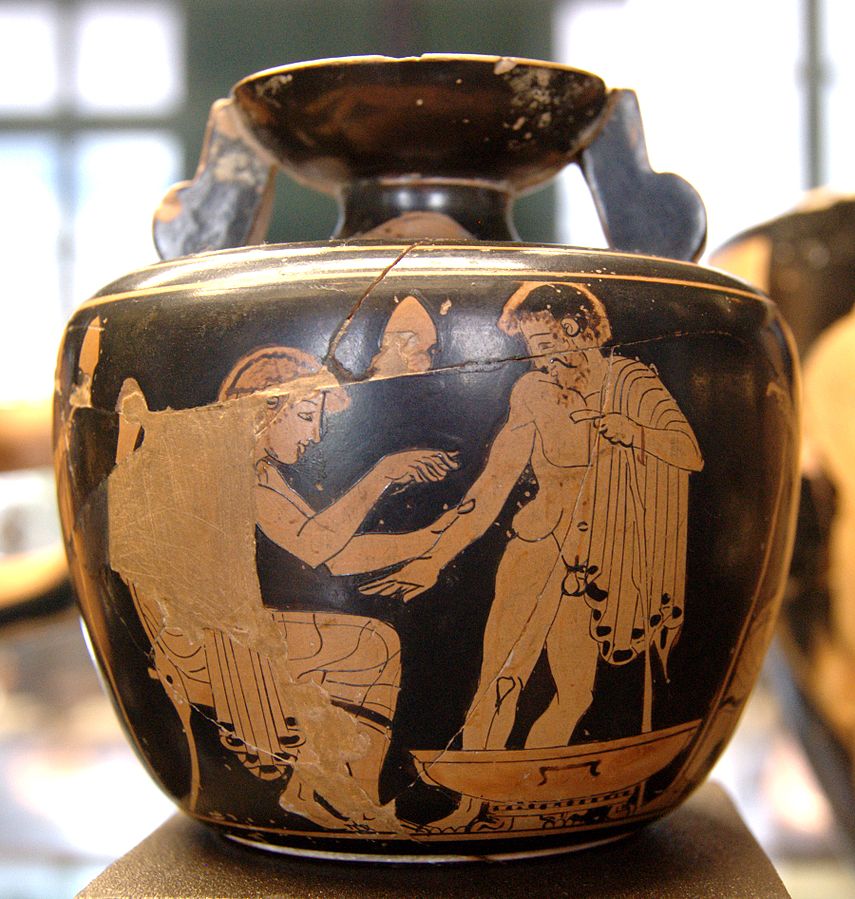
The first realistic depiction of an outpatient clinic in ancient Greece is on a drawing on a small vase created in Athens around 470 B.C. now on display at the Louvre Museum in France.
The drawing on the vase called aryvallos depicts a physician performing bloodletting on a patient. Another five males, four of them with injuries holding canes, are waiting their turn.
Among them, a dwarf holding a hare on his shoulder can be seen. Suction cups on the wall and a copper basin on the floor for blood collection are also included in the picture.

The characters depicted in the clinic of ancient Greece
The young physician of light complexion is depicted in a sitting position using a small type of lancet, to cause bloodletting from a vein of the right arm of an almost nude, bearded man with dark hair who is standing and supporting himself with a cane which he holds in his left hand.
The painting includes another five male figures. On the right side of the patient, there is a male figure. That man is sitting and is unclothed above the waist. He has a beard and dark hair. A bandage can be seen covering his upper arm.
Another man who is dressed and also has a beard and dark hair is standing behind him, raising his right hand in a gesture, as if addressing the physician. A bandage covers part of his left arm. It can be assumed that the two latter men are awaiting their turn to be examined.
An additional bearded man with dark hair is standing behind the previous one. He stands and crosses his feet. He has his right hand on his waist and is leaning to the left, supported by a crunch.
This last figure is looking down at a bearded nude dwarf who carries a hare on his shoulder. Finally, there is another man, who is dressed and has no beard and a light complexion. He appears to be moving with the support of a cane towards the rear of the physician who is sitting. A bandage covers part of his left leg.
On the wall, above the physician who is sitting, three suction cups can be seen—two on his left and one on his right side.
Earliest known realistic scene of medical service
The vase (aryvallos) depicts the earliest known realistic scene of medical service in Western history, the authors of a recent study wrote in the Journal of Clinical Medicine.
“All previous Ancient Greek scenes which dealt with relevant themes, invariably included ‘holy’ and divine interventions,” says co-author Manolis Stefanakis, Professor of classical archeology at the Department of Mediterranean Studies of the University of the Aegean.
“Trauma management, as well as bloodletting seem to form part of the everyday medical practice of that time, while gifts to physicians (one of the possible explanations of the dwarf’s hare, which is depicted in the aryvallos scene) were common.
“Additionally, historical sources reveal that Ancient Greek physicians were well-paid and much respected,” the Greek professor adds. “Medicine has always been an honorable practice throughout the centuries.”
“Through the illustration of the vase, the painter approaches in a rudimentary, but clear way, issues such as the space and furniture of the doctor’s office, the doctor’s position and attitude, his morals and remuneration, the patient’s attitude, the dressing of a wound—with indirect reference to the practice of phlebotomy and the use of bloody suction cups-, as well as the special case of achondroplasia, a genetic disorder that is the most common form of dwarfism,” Stefanakis told the Athens Macedonia News Agency (AMNA).
The vessel stands out for its two particularities: its shape and the figurative decoration it bears on the belly band.
As for the shape, it is relatively rare to find a spherical aryvallus in Attica, a shape—and a vase in general—that is mostly assigned to Corinth during the 7th and 6th centuries BC.
As far as the figurative decoration is concerned, the vase stands out both for its red-figure technique and for its historical contribution to the daily life of the ancient Athenians, being the only figurative testimony to date of an active Athenian medical center,” Stefanakis told AMNA.
See all the latest news from Greece and the world at Greekreporter.com. Contact our newsroom to report an update or send your story, photos and videos. Follow GR on Google News and subscribe here to our daily email!



